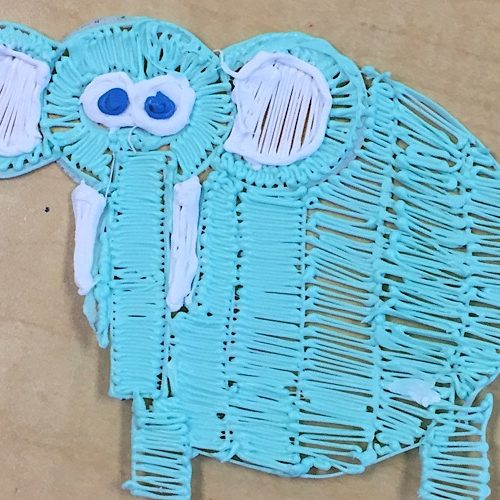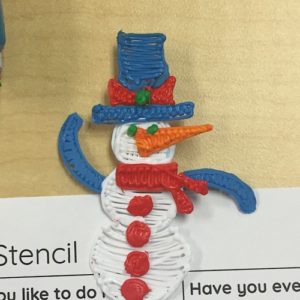MATH: Shape Shifters (Identifying Shapes and Attributes)
In this activity, students will work in pairs to identify shapes, and doodle a set of 3 different shapes to be welded together as a doodle-animal. Students will use geometry and creative thinking skills for this fun and engaging project.

Knowledge
Students have
practiced with the 3Doodler.
had practice drawing straight lines, outlines and fill with the 3Doodler.
practiced identifying and drawing shapes, i.e., circle, square, rectangle, triangle. (Kindergarten)
practiced identifying and drawing shapes, i.e., circle, square, rectangle, triangle, half-circles, trapezoids, and quarter-circles. (Grade 1)
practiced identifying and drawing shapes, i.e., circle, square, rectangle, triangle, half-circles, quarter-circles quadrilaterals, pentagons, hexagons, and cubes. (Grade 2)
practiced with the 3Doodler.
had practice drawing straight lines, outlines and fill with the 3Doodler.
practiced identifying and drawing shapes, i.e., circle, square, rectangle, triangle. (Kindergarten)
practiced identifying and drawing shapes, i.e., circle, square, rectangle, triangle, half-circles, trapezoids, and quarter-circles. (Grade 1)
practiced identifying and drawing shapes, i.e., circle, square, rectangle, triangle, half-circles, quarter-circles quadrilaterals, pentagons, hexagons, and cubes. (Grade 2)
Objectives
Students will
identify shapes.
draw shapes.
doodle shapes.
weld doodled shapes together to create a doodled animal.
identify shapes.
draw shapes.
doodle shapes.
weld doodled shapes together to create a doodled animal.
Materials
Students will need
Lesson Plan
Instructions
Step 1 - PREPARATION
Draw and cut out an example of one of each shape that will be used in this lesson.
*The shapes used will depend on the grade level. Refer to the grade-specific worksheets.
Step 2
Whole Group: Review the shapes that are relevant to the grade level.
Kindergarten: circle, square, rectangle, triangle.
Grade 1: include trapezoids, half-circles, and quarter-circles.
Grade 2: include quadrilaterals, pentagons, hexagons.
Step 3
Have students come up and practice drawing shapes. Instruct students to identify attributes of shapes, e.g., number of sides, corners, parallel lines, angles, etc.
Step 4
Choose 3 shapes and demonstrate how to put them together to create an animal.
*See Appendix.
Step 5
Project your tablet or computer screen on the board and review Doodle-Ella from the Shape Shifter Worksheet. Review the shapes that were used to create Doodle-Ella. Note why certain shapes were used. Examples: Circle for her round head. Triangles for her tusks.
Step 6
Share the goal: Students will create a stencil drawing of a Doodle-Animal using 3 different shapes.
*The shapes use will depend on the grade level.
Step 7
Guided Practice: Use precut shapes to practice identifying and arranging them in different ways to create animals. Invite students to help you.
Step 8
Hand out Shape Shifter Worksheets to each pair of students and allow time to sketch out their stencils of Doodle-Animals. Check their work.
Step 9
Whole Group: Demonstrate how to doodle a Doodle-Animal using the shape drawing as a stencil. Begin with the outline. Segment-off larger fill areas with your pencil.
*See Appendix.
Step 10
Pass out 3Doodlers and circle to assist and assess.
Step 11
Students can optionally create stands for their Doodle-Animals. The rectangular stencil is located on each grade-level Shape-Shifter Worksheet. The students can create the stand and then weld the doodled animal to the stand with extruded plastic.
Draw and cut out an example of one of each shape that will be used in this lesson.
*The shapes used will depend on the grade level. Refer to the grade-specific worksheets.
Whole Group: Review the shapes that are relevant to the grade level.
Kindergarten: circle, square, rectangle, triangle.
Grade 1: include trapezoids, half-circles, and quarter-circles.
Grade 2: include quadrilaterals, pentagons, hexagons.
Have students come up and practice drawing shapes. Instruct students to identify attributes of shapes, e.g., number of sides, corners, parallel lines, angles, etc.
Choose 3 shapes and demonstrate how to put them together to create an animal.
*See Appendix.
Project your tablet or computer screen on the board and review Doodle-Ella from the Shape Shifter Worksheet. Review the shapes that were used to create Doodle-Ella. Note why certain shapes were used. Examples: Circle for her round head. Triangles for her tusks.
Share the goal: Students will create a stencil drawing of a Doodle-Animal using 3 different shapes.
*The shapes use will depend on the grade level.
Guided Practice: Use precut shapes to practice identifying and arranging them in different ways to create animals. Invite students to help you.
Hand out Shape Shifter Worksheets to each pair of students and allow time to sketch out their stencils of Doodle-Animals. Check their work.
Whole Group: Demonstrate how to doodle a Doodle-Animal using the shape drawing as a stencil. Begin with the outline. Segment-off larger fill areas with your pencil.
*See Appendix.
Pass out 3Doodlers and circle to assist and assess.
Students can optionally create stands for their Doodle-Animals. The rectangular stencil is located on each grade-level Shape-Shifter Worksheet. The students can create the stand and then weld the doodled animal to the stand with extruded plastic.
Wrap Up
Assessment
Possible Extensions
Resources
Outline each area first before filling. Segment-off larger fill areas before filling in, as has been done on the elephant's torso. Fill with a back and forth motion, ensuring to make contact with the outline each time. This will anchor the plastic to the outlined frame.
Vocabulary
2-dimensional - of, relating to, or representing something in two dimensions.
3-dimensional - of, relating to, or representing something in three dimensions.
acting - the art or practice of representing a character before an audience.
circle - a closed plane curve consisting of all points at a given distance from a point within it called the center.
collaboration - to work jointly with others or together especially in an intellectual endeavor.
color - the quality of an object or substance with respect to light reflected by the object, usually determined visually by measurement of hue, saturation, and brightness of the reflected light; saturation or chroma; hue.
comparing - to examine the character or qualities of especially in order to discover resemblances or differences.
cube - a regular three-dimensional shape composed of six square faces.
drawing - the art or technique of representing an object or outlining a figure, plan, or sketch by means of lines.
half-circle - a half of the circumference of a circle
hexagon - a polygon of six angles and six sides.
pentagon - a polygon of five angles and five sides.
problem-solving - the process or act of finding a solution to a problem.
quadrilateral - a polygon of four sides.
quarter-circle - a quarter of the circumference of a circle.
rectangle - a parallelogram all of whose angles are right angles; especially : one with adjacent sides of unequal length.
shapes - the quality of a distinct object or body in having an external surface or outline of specific form or figure.
square - a two-dimensional shape with four sides of equal length and four right angles.
trapezoid - a quadrilateral having only two sides parallel.
triangle - a polygon having three sides.
writing - any written or printed paper, as a document or deed.
Educational Standards
Correctly name shapes regardless of their orientations or overall size.
Students will name shapes during group and partner work during this activity.
Distinguish between defining attributes (e.g., triangles are closed and three-sided) versus non-defining attributes (e.g., color, orientation, overall size); build and draw shapes to possess defining attributes
Students will distinguish defining attributes during group and partner work during this activity.
Recognize and draw shapes having specified attributes, such as a given number of angles or a given number of equal faces.1 Identify triangles, quadrilaterals, pentagons, hexagons, and cubes.
Students will recognize and draw shapes having specified attributes during this activity.
Decompose (break down) a larger problem into smaller sub-problems with teacher guidance or independently.
Students will break down the process of recognizing, identifying and understanding attributes of shapes during the process of designing and modeling Doodle-Animals.
Use technology to seek feedback that informs and improves their practice and to demonstrate their learning in a variety of ways.
Students will use the 3Doodler to create doodled models of shapes, identify them and assemble them as a Doodle-Animal.
Create original works or responsibly repurpose or remix digital resources into new creations.
Students will use a 3Doodler to compose 3 doodle shapes into a Doodle-Animal.
Use collaborative technologies to work with others, including peers, experts or community members, to examine issues and problems from multiple viewpoints.
Students will seek feedback from peers throughout their stencil- design, as well as the doodling portion of this project.


